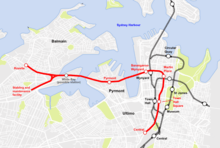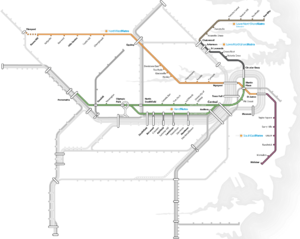CBD Metro
| CBD Metro | |
|---|---|
|
| |
| Mode |
Rapid Transit cancelled |
| Owner | Sydney Metro Authority |
| Connects | Central, Town Hall, Martin Place, Wynyard |
| Length | 9 km (5.6 mi) |
| Stations | 6 |
| Key dates | |
| October 2008 | Line announced |
| February 2010 | Line cancelled |

CBD Metro was a proposed metro line running in Sydney, Australia announced on 23 October 2008. It was to be undertaken by the NSW State Government and was placed on a short-list of projects to be funded by Infrastructure Australia's Building Australia Fund in December 2008.[1] The CBD Metro was designed to cater to the "CBD Growth Centre" and was identified as the enabling "central spine" to a proposed larger metro system for Sydney, including extensions to the west and possibly the north-west.[2]
The CBD Metro would have consisted of a 9-kilometre (5.6 mi) track railway running from Rozelle and Pyrmont to connect with Wynyard, Town Hall and Central. The project would have included a train stabling facility to the west of the new Pyrmont station.[3] The new Euro-style metro was proposed to offer a rail service of one train every four to five minutes (three minutes during peak hours). It would have run on conventional standard gauge track, similar to the existing CityRail network, but would have operated without drivers. It was to run single deck rolling stock along the route of the proposed CBD Metro.
The CBD Metro was cancelled on 21 February 2010, by NSW Premier Kristina Kenneally as part of the Metropolitan Transport Plan: Connecting the City of Cities, 2010.[4] The plan announced the CBD Relief Line, a heavy rail line that essentially replaces the CBD Metro.
Proposed route
| CBD Metro | |||||||||||||||||||||||||||||||||||||||||||||||||
|---|---|---|---|---|---|---|---|---|---|---|---|---|---|---|---|---|---|---|---|---|---|---|---|---|---|---|---|---|---|---|---|---|---|---|---|---|---|---|---|---|---|---|---|---|---|---|---|---|---|
Legend
| |||||||||||||||||||||||||||||||||||||||||||||||||
The final proposal revealed had the CBD Metro running from Rozelle to Central station, connecting with the proposed West Metro at Central station. The new metro stations would have provided connections with existing CityRail network at Wynyard, Martin Place, Town Hall, and Central stations.
The proposed route would have included 6 new metro stations:
- Rozelle- This station was to be located near Darling Street at Victoria Road, and was controversial within the local community.
- Pyrmont- This station was to be located in the Union Square area with a number of heritage buildings to be demolished.
- Barangaroo-Wynyard- This station was proposed to serve the Barangaroo development area with connections to the Wynyard Cityrail station.
- Martin Place
- Town Hall Square- This station would be one block east of the current Town Hall Station, and requiring demolition of the Woolworths building
- Central - West of the current station, near Railway Square.
Other proposed extensions
According to Sydney Metro Authority's publications,[5] the CBD Metro was proposed to connect with the West Metro from Central to Westmead via Leichhardt. Considerations were also taken to extend the CBD Metro to Epping via Macquarie Park partly along the alignment of the (previously) cancelled North West Metro. Both extensions would have formed part of the proposed City West Line (Metro Line 1). However, as the CBD Metro has been scrapped, it is unlikely that any other metros will be considered in the near future.
Criticism

The CBD metro had been criticised by both the head of RailCorp[6] and the NSW Property Council[7] as using a much-needed protected corridor for the proposed additional heavy rail corridor through the CBD of Sydney. This line, it is claimed, would be needed to provide extra capacity on the CityRail network to ease congestion and allow growth into the future. The Sydney Morning Herald reported that Transport Minister David Campbell had admitted the CBD Metro would run up to 87% empty during peak hour on its opening in 2015 and up to 76% empty in 2031. During peak hour, the CBD Metro is projected to carry 4,000 - 5,500 passengers per hour in 2015 and 7,250 passengers per hour in 2031 out of a full capacity of 30,000 passengers per hour. The dumped, alternative proposal for a second heavy rail harbour crossing running between Redfern and Chatswood would have incurred a similar cost but was projected to carry 16,000 passengers per hour, more than four times the CBD metro.[8]
Formerly starting the proposal for a CBD Metro in early 2009, the NSW Labor Government applied for environmental assessment study with the NSW Department Of Planning. This was put on public display during September 2009. During this time members of the public and Government Departments were invited to comment and make submissions.
Unpopular across the community, the CBD Metro proposal has come into much criticism both in logistics and the proposed cost. It was discovered after the close of submissions, that the original 2 billion dollar cost had blown out to 7 billion dollars, due to problems with construction. Also it was made public that two Councils, City Of Sydney and Leichhardt Municipal Council, had written submissions fiercely critical of the CBD Metro proposal.
As of December 2009, the CBD Metro project again caused problems for the NSW Labor Government, after the Sydney Metro Authority indicated it would forcefully resume properties despite having no approval from the NSW Department Of Planning. It is expected that the iconic Woolworths Building in Park Street, would have also fallen victim and be forced to close.
Cancellation
A new premier of NSW, Kristina Keneally, halted the compulsory property acquisitions at Rozelle during January 2010. This prompted speculation that the CBD Metro would be cancelled. On Saturday, 20 February, a special weekend cabinet meeting was convened to sort out the issue. The following day, Keneally formally announced the cancellation of the metro program – including the CBD Metro. The government's Metropolitan Transport Blueprint includes the City Relief line, which is a similar concept to the CBD Metro. The City Relief line links into CityRail's Western line, instead of forming the basis of a new system.
See also
References
- ↑ Besser, L. Sydney shortlisted for billions, Sydney Morning Herald, 19 December 2008.
- ↑ Metro: The Future of Transport
- ↑ Benson, S. Northwest Metro rail link officially shelved Daily Telegraph, 31 October 2008.
- ↑ Keneally unveils transport blueprint ABC News 21 January 2010.
- ↑ Metro: The Future of Transport NSW Government. 30 June 2009
- ↑ Besser, L. Metro plan threatens to derail city. Sydney Morning Herald, 21 January 2009.
- ↑ Besser, L. Train-corridor review 'folly'. Sydney Morning Herald, 22 January 2009.
- ↑ Besser, L. CBD Metro will run almost empty, Sydney Morning Herald, 4 May 2009.